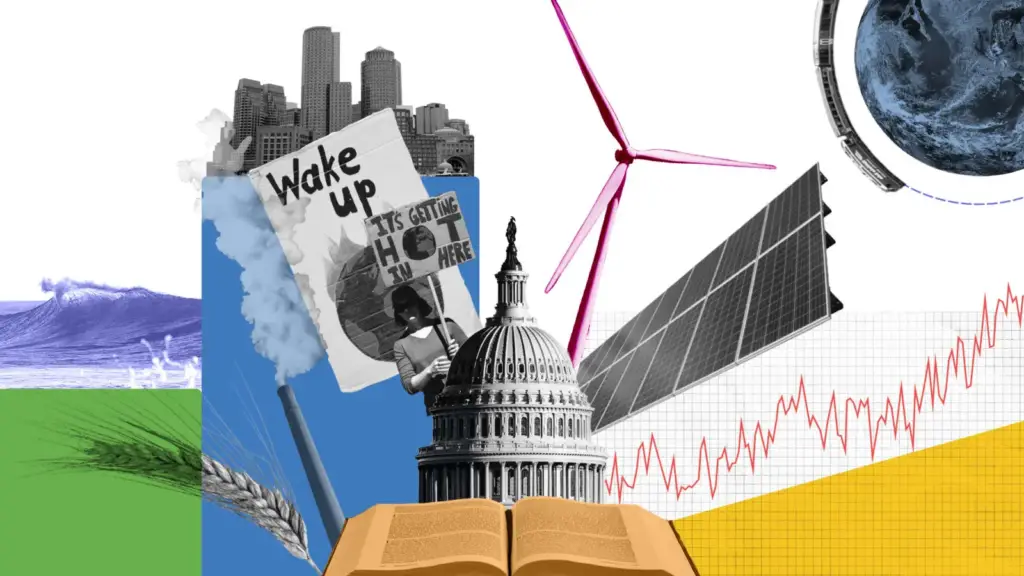Reviewed by Ogbo Godfrey
The climate change policies in USA, as of this year, 2023, are carbon pricing mechanisms, transportation overhauls, renewable energy incentives, etc.
Climate change has emerged as one of the most pressing challenges of our time, transcending borders and demanding swift and comprehensive action.
In 2023, the United States finds itself at a crucial juncture in its battle against this global crisis.
With the impacts of climate change becoming increasingly evident, the policies enacted this year hold the potential to shape the nation’s environmental trajectory for decades to come.
In the ever-evolving narrative of climate policies, the USA’s actions in 2023 will undoubtedly leave a lasting impact on the planet and the generations that will inherit it.
While challenges persist, the prevailing spirit of innovation, collaboration, and the recognition of the shared responsibility for our planet’s well-being offer hope.
From federal regulations to grassroots initiatives, international diplomacy to local innovation, the different strategies used reflect a nation committed to charting a sustainable course forward and show the importance of climate change policies in USA.
This article delves into the intricate web of climate change policies in USA, highlighting the advancements, setbacks, and collaborative efforts that define the nation’s approach this year.
Historical Context

To understand the present, it is essential to trace the evolution of climate change policies in USA. Over the past decades; the nation has witnessed various approaches, reflecting the changing tides of public opinion and scientific understanding.
Political will, and landmark moments such as the Clean Air Act of 1963 laid the foundation for addressing air pollution and its climate-related implications.
Subsequent milestones, including establishing the Environmental Protection Agency (EPA) in 1970 and ratifying the Paris Agreement in 2016, showcased the country’s commitment to mitigating its carbon footprint.
However, the road has been marked by fluctuations in policy priorities, with different administrations adopting varying levels of enthusiasm for environmental protection.
This historical context underscores the significance of the climate change policies in USA, formulated in 2023, unfolding against the backdrop of an ever-changing landscape of attitudes and approaches.
Current Climate Change Policies
In 2023, the USA stands at a crossroads with a confluence of policies and initiatives to address climate change. The year has witnessed a multifaceted approach, with a mix of federal regulations, state-level actions, and international engagements.
Key climate change policies in USA implemented this year include:
1. Clean Energy Standard (CES)
The federal government introduced the CES, setting ambitious targets for adopting clean energy sources such as wind, solar, and hydroelectric power. This policy aims to reduce greenhouse gas emissions from the energy sector by a substantial margin over the next decade.
2. Carbon pricing mechanisms
Several states have taken the initiative to implement carbon pricing mechanisms, such as cap-and-trade systems and carbon taxes. These mechanisms provide economic incentives for industries to reduce their carbon emissions.
3. Transportation overhaul
Recognising the transportation sector’s significant contribution to emissions, various cities have invested in public transportation expansion, electric vehicle charging infrastructure, and pedestrian-friendly urban planning.
4. Renewable energy incentives
Federal and state governments have rolled out incentives to accelerate the adoption of renewable energy technologies, including tax credits for solar installations and research grants for innovative clean energy solutions.
5. Conservation and Reforestation
To mitigate the impacts of deforestation and land degradation, initiatives promoting reforestation and the preservation of natural habitats have gained traction across multiple states.
6. Climate adaptation measures
With the recognition of the inevitability of specific climate impacts, efforts have been made to bolster the resilience of communities through measures like improved infrastructure planning and disaster response strategies.
This diverse tapestry of climate change policies in USA, illustrates a concerted effort to address climate change from various angles, reflecting a growing recognition of the need for holistic solutions in the face of a complex and interconnected challenge.
Federal Regulations
At the federal level, 2023 has witnessed a resurgence of climate change regulations and initiatives, signaling a renewed commitment to environmental stewardship. The government’s strategies include:
1. Emission reduction targets
The USA has set ambitious emission reduction targets, aligning with international agreements to limit global temperature rise. These targets serve as a rallying point for domestic policies and international collaboration.
2. Clean infrastructure investment
A substantial allocation of federal funds has been directed towards developing clean infrastructure, encompassing renewable energy projects, electric vehicle charging networks, and modernized public transportation systems.
3. Environmental justice focus
Recognising the disproportionate impact of climate change on marginalized communities, federal regulations have emphasized environmental justice, aiming to ensure equitable distribution of both the burdens and benefits of climate policies.
4. Carbon Capture and Storage (CCS)
The government has incentivised developing and deploying CCS technologies to capture and store carbon emissions from industrial processes and power generation.
5. Phasing out fossil fuel subsidies
Steps have been taken to reduce subsidies to the fossil fuel industry, redirecting financial support towards sustainable energy solutions and innovation.
These federal regulations depart from previous years, emphasizing a comprehensive and integrated approach to tackling climate change while fostering economic growth and job creation in emerging green sectors.
State and Local Initiatives
While federal policies provide a framework, state and local governments have emerged as vital drivers of the climate change policies enacted in USA. In 2023, a diverse array of initiatives at these levels include:
1. Renewable Portfolio Standards (RPS)
Many states have enacted RPS, mandating a specific percentage of energy generation from renewable sources. These standards encourage the expansion of renewable energy capacity within state borders.
2. Green Building Codes
Several cities have adopted stringent green building codes, requiring new constructions to meet energy efficiency and sustainability criteria.
3. Coastal Resilience Plans
States with vulnerable coastlines have developed resilience plans to prepare for the escalating threats posed by rising sea levels and extreme weather events.
4. Decarbonization Roadmaps
Some states have formulated comprehensive decarbonisation roadmaps outlining step-by-step strategies to transition their energy systems from fossil fuels.
5. Local Carbon Markets
Experimental carbon markets in certain cities allow local businesses to trade carbon credits, fostering emissions reduction in urban environments.
The proliferation of state and local initiatives underscores the adaptability and innovation present in American communities.
It also reflects the understanding that effective climate solutions often arise from tailored approaches considering local contexts and needs.
International Engagements

The climate change policies in USA extend beyond national borders in an era of interconnected global challenges. In 2023, the nation has been actively engaged in international efforts, demonstrating its commitment to collaborative solutions:
1. Paris Agreement Commitments
The USA has reaffirmed its commitment to the Paris Agreement, setting ambitious targets for emission reductions and sustainable development. This move has signalled a return to global climate leadership after a withdrawal period.
2. Diplomatic outreach
Bilateral and multilateral engagements have seen the USA collaborating with other nations to share best practices, technologies, and expertise in climate mitigation and adaptation.
3. Global climate funds
The USA has increased its contributions to international climate funds to support developing nations’ climate resilience efforts and transitions to low-carbon economies.
4. Climate diplomacy
Climate change has been integrated into diplomatic agendas, fostering conversations on climate-related security risks and fostering cooperation in addressing these challenges.
The USA’s participation in international efforts speaks to the recognition that climate change is a shared problem demanding a collective response.
By aligning its policies with global imperatives, the nation aims to contribute to a sustainable and resilient planet for current and future generations.
From federal regulations to state-level innovations, the various approaches highlight the diverse strategies employed to tackle an issue that transcends boundaries.
Challenges
Despite the strides taken in 2023, the landscape of climate change policies in USA is not without its challenges and criticisms:
1. Political polarisation
Climate policies continue to face partisan divisions, which can hinder the implementation of comprehensive and long-term strategies.
2. Transitioning workforce
The shift towards renewable energy and clean technologies raises concerns about the impact on workers in traditional industries, necessitating effective job transition programs.
3. Equity concerns
Ensuring climate policies benefit all communities equitably remains a challenge, as vulnerable populations may still bear the brunt of environmental burdens.
4. Resource allocation
The allocation of financial resources towards climate initiatives competes with other pressing priorities, necessitating careful balance and efficient use of funds.
5. Regulatory complexity
Navigating the complex web of federal, state, and local regulations can pose challenges for businesses and organizations aiming to comply with climate policies.
While these challenges underscore the issue’s complexity, they also highlight the need for ongoing dialogue, adaptation, and fine-tuning of policies to create a more inclusive and practical approach to addressing climate change in the USA.
Future Outlook
Looking ahead, the trajectory of climate change policies in USA is poised to be shaped by several factors:
1. Election cycles
The direction of policies may continue to shift with changing administrations, underscoring the need for durable, bipartisan climate strategies.
2. Technological innovation
Advances in technology, including renewable energy breakthroughs and carbon capture techniques, could accelerate emissions reductions and reshape the energy landscape.
3. Public awareness
Increasing public awareness and demands for climate action could drive policymakers to prioritise sustainable solutions.
4. Global cooperation
Continued collaboration with international partners will be crucial to addressing the global nature of climate change.
5. Legal and regulatory evolution
Legal interpretations and court decisions could further define the scope and reach of climate policies at different levels of government.
Conclusion
In 2023, the USA finds itself at a crucial juncture in its battle against climate change. This year’s policies reflect a nation grappling with the urgent need for environmental stewardship, sustainable growth, and global cooperation.
As we navigate the complexities of the climate change policies in USA, the journey is a testament to the nation’s ability to adapt, learn, and chart a course toward a greener, more resilient future.
Related posts:
- 389 Adjectives Starting with Z (Positive Words and Others) - January 12, 2024
- 389 Adjectives Starting with Y (Positive words and Others) - January 11, 2024
- 389 Adjectives Starting with X (Positive words and Others) - January 10, 2024







2 thoughts on “Climate Change Policies in USA: A 2023 Review”